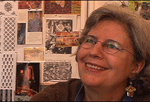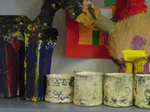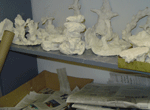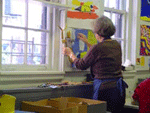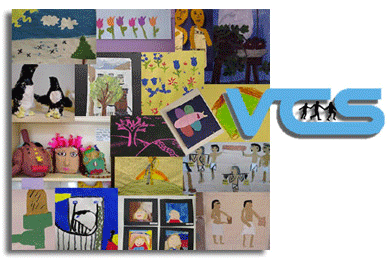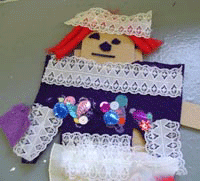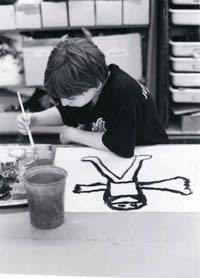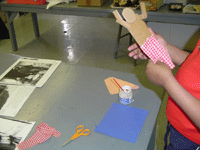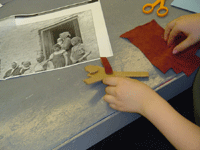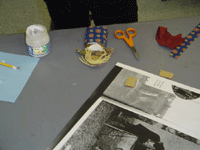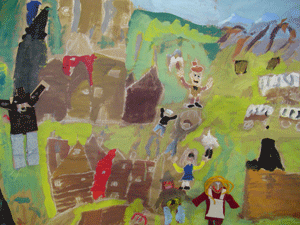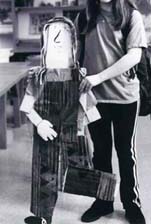 |
 |
 |
 |
|
|
|
Nancy Beal has taught art to children for thirty years at the Village Community School in New York City. She captured her teaching experience and philosophy in her book, The Art of Teaching Art to Children in School and at Home, published in 2001. Prior to her art teaching career, she was a classroom teacher. She received a Master of Arts in Early Childhood from Bank Street College of Education in New York City. She has shown her paintings in and around New York, and is a founding member of the Bowery Gallery in New York City and the Flywheel Gallery in Piermont, NY. She lives with her family in Manhattan. |
|||||
The Art of Teaching Art to Children In School and At Home. By Nancy Beal. (Read excerpts and reviews) |
|||||
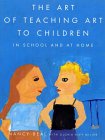 |
(c) 2001, New York: Farrar, Straus and Giroux, 214 pages. Features: |
||||
|
|||||
"No one has been more of an inspiration to me than Lois Lord, who has been my teacher and friend since I met her in 1970. Lois is a photographer and master teacher who has shared generously her great knowledge of children and the importance and meaning of art in their lives. She wrote Collage and Construction in School: Preschool-Junior High School in 1958, which was reprinted by the Bank Street College of Education in 1996. This in depth approach to collage and construction offers a wealth of excellent suggestions on materials and motivations. Lois's work is based on a keen understanding of children's developmental growth." --Nancy "I have also been inspired and sustained over the years by the hugely valuable work of Nancy Smith, who, after working with Lois, wrote Experience and Art, Teaching Children to Paint (New York: Teachers College Press, 1983, 1993). I find it to be the single most valuable study of children's painting and the process by which they can be helped to paint. A 'must' for art teachers, it is based on how children grow, think, learn, and express themselves. The book also includes motivational questions for all age levels." --Nancy |
|||||
|
|
The Village Community School is a private elementary school in Manhattan's West Village. It was founded in 1970 with the mission of "developing self-motivated students who view learning as an exciting and rewarding process that will continue throughout their lives" through a social-studies based curriculum, an experiential and interdisciplinary learning environment, and a commitment to teach each child according to that child's personal learning style. Currently, 300 students attend VCS. Nancy's average art class size is 11, half of the standard VCS class size, as she teaches the two parts of each class in separate 45 minute time blocks. 6th-8th graders in the school can add 45 minute elective art periods to their schedules. |
||||
At VCS, art is considered a major language of childhood and an important way for children to learn about their world and to communicate their thoughts and feelings. Our goal is to empower children with different art materials, processes, skills, and tools and to promote their confidence in their own personal expression. We facilitate opportunities for in-depth exploration of materials, along with motivating discussions that help children think and feel deeply about their own experiences. We describe what is aesthetically strong and how examples from art history might be helpful. We encourage children to make order themselves, try out their own ideas, integrate new information, and resolve their art work according to their own pace and plan. The VCS philosophy emphasizes process, the individual, and is based upon knowledge of children's visual expression at different developmental levels. With this approach, we have observed that most of the children at VCS plunge into art with confidence and joy and that the experience builds self-esteem. |
|||||
Nancy's Approach at Different Age Levels 5-6 Year Olds
Motivating Questions: •How would you like to put these together? •What do you like to do with someone in your family? •What do you like to do in the snow? •How do you come to school? •How would you like to come to school if you could come any way you wanted to?
Explore stick puppet making with the 5 and 6 year olds [includes video clips of class] |
The youngest children explore materials and use large motor gestures to move paint boldly or squeeze clay actively. Art materials are largely self-motivating and include paint, clay, collage, puppets, 3D construction, printmaking, and drawing. Gradually children discover how to mix new colors on the paper and then on the tray. They begin to paint lines and shapes in increasingly complex designs. They pound, tunnel and squeeze clay and begin to model designs and images. Collage and construction are offered in the same spirit of "work-play" and the children find ways to tear, cut, fold, arrange, and glue. They often share by showing their work and explaining their discoveries. Attention is given to routines so that the children can work independently and with a maximum sense of order and integrity of materials. Four and five-year-olds are both figurative and pre-figurative with their imagery and by six most children move naturally into figuration. Classes begin with a motivating discussion either about shapes and colors or, for those children who are ready to symbolize, questions about people and animals, vehicles, buildings, and places. Good motivating questions invite wide open, personal responses and any "answer" the children give is fine, it is theirs, it is not a product a teacher had in mind in advance. Watching the children paint in response to these motivations, one can clearly observe strong emotional connections to what they are doing. They may even become so involved that it is as if they are re-enacting their experiences. We value this personal investment and we see time and again the individual expression of children in what they most care about--this, after all, is the domain of any artist. The children's classroom curriculum sometimes becomes subject matter for the art experience. Art teachers and classroom teachers confer, and lessons are developed to integrate art with social studies or science. For example, block building is a big part of 5-6's classroom life, and stick puppet materials are made available. These 3D "objects" are a precursor to symbolizing people and animals on paper and they are used to enhance block dramatic play. While studying tree animals, the 6-7's have created animal environments in paper mache construction as well as imaginary animals in collage. Other 6-7's have painted a "pond-life" mural after a trip to study pond life in Central Park. They have drawn and painted wax-resist underwater scenes and sewed stuffed felt fish with correct fins and lateral lines. |
||||
7-10 Year Olds Motivating Questions: •How can you show lots of textures? •What do you like to do when you're wearing sneakers? When do you like to climb? Kick? Go in water? •What do you like to do when you're sitting? (For clay activities) •How would you design your "dream room" or build a vehicle with boxes? (For construction activities)
Children's objectivity increases at this age |
At this age, children's images become increasingly representational. Seven year olds are logical in a concrete way--the "earth" or "ground" is below and the sky is above. Formerly schematic (i.e. often repeated), people and houses become "my brother," "my building," "my grandparents' condo." Children are observing more details and are struggling with ways to visually represent them. The VCS program aims to balance exploration acitivities with motivations that tap the child's interests. Themes that support this age's emerging objectivity include social events, figures in action, and fantasy and humor subjects. We believe that the motivating questions need to be focused on the significant experiences of young children so that the children are involved in the creation of meaning. When children want help with representing space, we may teach about overlap, aerial perspective, size or linear recession and we encourage children to discover their own answers. Because each child's way of working is encouraged and respected, children of all different abilities can find success. Children help each other. There is no one right answer.
8-9 Year-Olds' stick puppets support art's integration with a Social Studies unit on westward expansion. |
||||
Middle Years Motivating Questions: • How can lines show movement or stillness? • When do you go fast? •What are times when you celebrate?
An example of stick puppet making at an older developmental stage
An example of art/social studies integration: papier-mache Greek hero by an 11-year-old |
Older children develop a more critical awareness of their work and they paint more descriptively. They want to learn techniques that will enhance their expressive accuracy such as receding space, modeling, and light and shading. They continue to work with the basic materials--paint, clay, collage, drawing, construction and printmaking. Our program aims to balance exploration of materials with structured problems and with motivations that tap the child's interest. We focus on process and mastery of materials. The class begins with a motivation which deepens the children's personal connections with the subject in a narrative and emotional way. Children learn various techniques to improve their descriptive accuracy, such as creating mood and modeling light, joining well, hard and soft edge, primary and complementary color, and shading and tinting. Because the figure is an important part of children's imagery, special attention is given to how to draw, paint, and model the figure. We work with ways to represent people, including "sausage figures" using strips or ovals to arrange the figure and show how elbows and knees help to express action. Children also draw the posed figure from observation as well as portraits and still life. We encourage children to solve problems and discover their own answers. Because each child's way of working is encouraged and respected, children of all different abilities can find success. Children help each other. There is no one right answer. Also of great importance to the middle years curriculum at VCS is the integration of art with social studies and science. Art and classroom teachers meet during the year to discuss ways in which art activities can enhance classroom curricula. They sometimes share field trips and art activities for both the classroom and the studio. Examples of class curriculum-related art activities abound: quilt designing and the Amish, Eastern brushwork and calligraphic city scapes, Japanese-style lino cuts, Native American pinch pots fired in a homemade kiln, weaving, beadwork, Inuit fur and leather dolls, "soapstone" Eskimo animals, Dutch tiles, clay and papier mache dinosaurs, Islamic tessellated tile work, Roman mosaics, etc. Children also paint murals and scenery and make props and costumes for plays. |


